#he's a county Councillor
Explore tagged Tumblr posts
Text
Canoodling rn
Not that anyone cares
#canoodling#caimiléireachta#Séamus dubh needs to cop the fuck on i cannot answer these questions#and Seosamh that little prat needs to learn to keep his nose out of other people's business#who gives a fuck is Séamus and peadairín are illegally ag dumpáil sa Glenn Álainn?#go péinteáil somewhere the fuck else and let them ag magdah their fucking bhfógras in peace#and like why is yer one so pressed about her father being caimiléireacht?#like hun#calm yourself#please#we're irish#like being caimiléireacht is our whole job#i do not know ONE SINGLE not caimiléireacht person#stop erasing our culture pookie#sean mac an mhaistir can give as many breabs to the oifigeach as he likes#it's not like he's fucking varadkar#he's a county Councillor#like i really have to be out here all#Bhí an fearg ar cheann de mo mhothúcháin agus an dráma seo a léamh#like I give a FUCK about seanie boys breabs#oh fuck I'm going to fail my mock
1 note
·
View note
Text
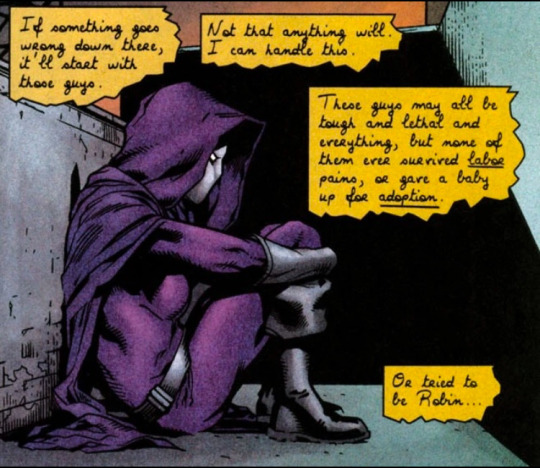
Correcting things I’ve seen people get wrong and lie about Stephanie’s pregnancy and her ex boyfriend because its slowly becoming its own fanon: (tw: for teen pregnancy)
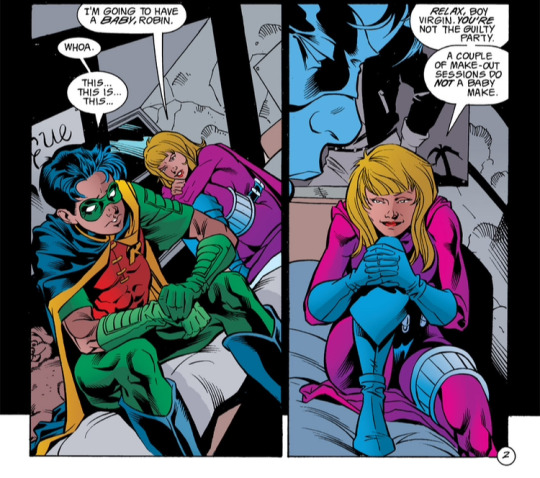
Tim is not the father, I can’t stress enough how Tim is very much not the father, the father is her ex boyfriend Dean

We don’t know when they got together but Stephanie was dating Dean up until cataclysm, meaning she was attempting to cheat on him with Robin (though unsuccessfully) Dean wasn’t cheating on her
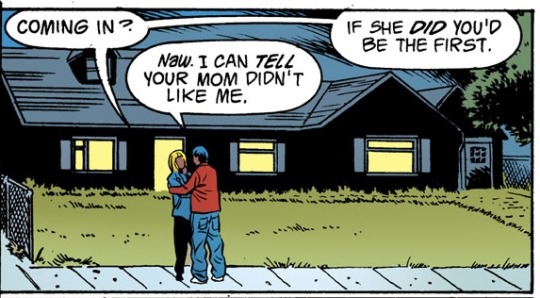
Although we don’t know if she dated them officially it’s implied Steph had more than one unnamed partner before Dean, he’s not her first boyfriend

Dean is not an old man, he’s a teenager, though Stephanie does have trauma related to older men (her babysitter Murray) and a very creepy uncle named Dave
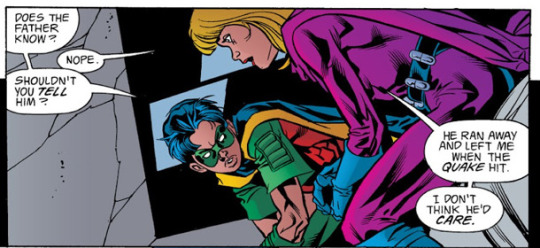
Dean didn’t leave because of the pregnancy, he left because of the earthquake, Steph explicitly says that she didn’t tell him
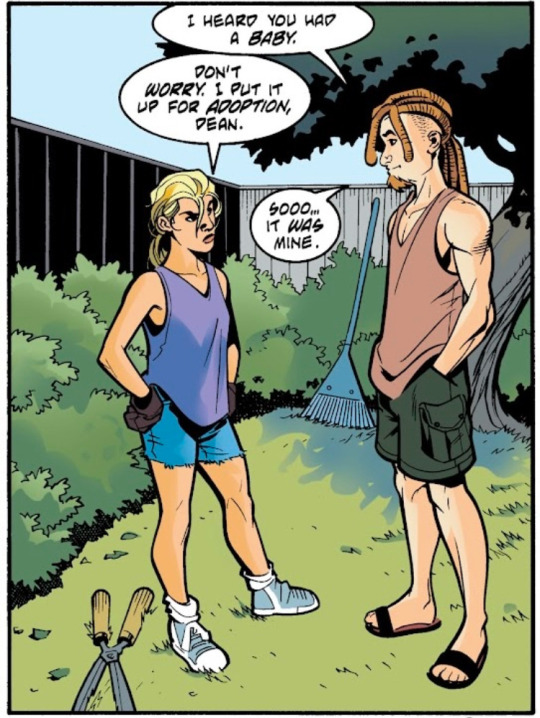
Dean does eventually find out about the baby, though a significant amount of time after it’s already been given up, but didn’t know if it was his or not until he asks her

Steph didn’t beat Dean up because of the baby, she very explicitly says he’s not the one she’s mad at (she was mad at Tim) Steph also beats up another teenager Tito for the same reason

The sex was underage (Steph was 15) and unprotected but it was consensual, Dean was said to be a jerk but he was never harmful
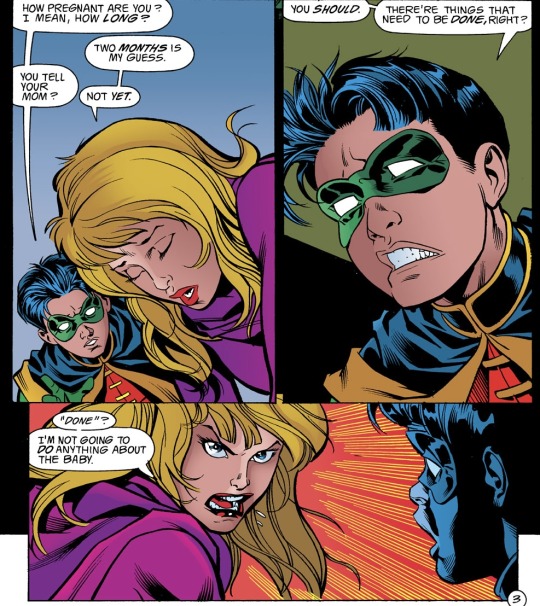

Stephanie was always very against the idea of getting an abortion and would get very angry if anyone suggested it

Stephanie went to birthing classes (with Tim in his Alvin Draper disguise), she also saw a councillor at Gotham county social services, though temporarily, was able to homeschool and take her books home and had her mom supporting her completely

Steph declined an agency offering her money for a healthy baby, it’s unclear how many others she went to but the one she settled on was “st. Swithins”
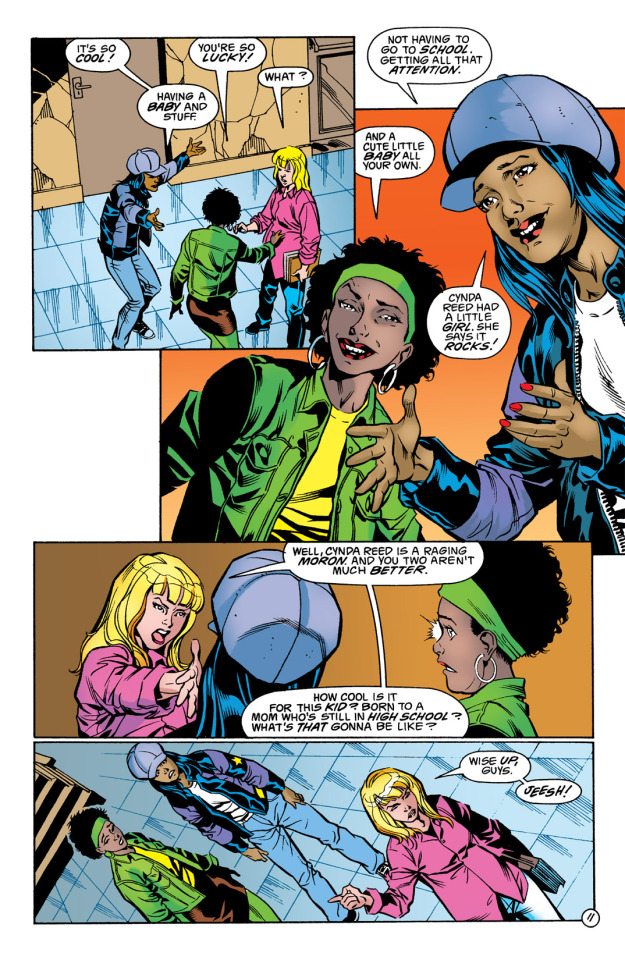

Although she did consider keeping her own baby Stephanie didn’t have very high opinions of teen mothers, she called her classmate Cynda Reed, who unlike Steph had already had her baby and was raising it, a “raging moron” telling Cyndas (quite naive) friends who were trying to be supportive they were also morons and should wise up (she also later calls them stupid)
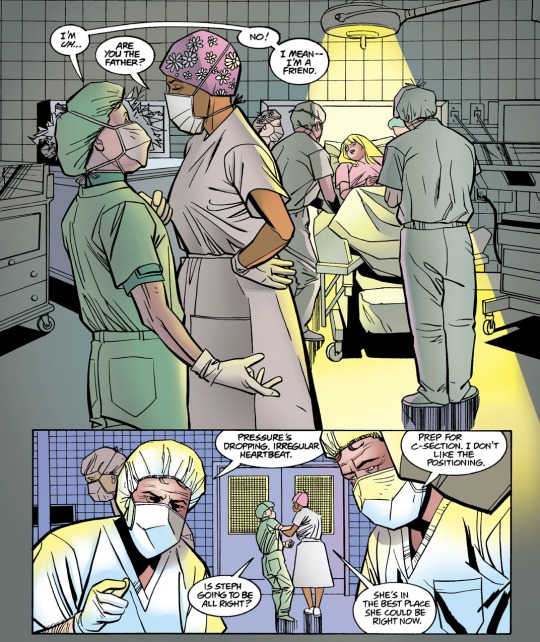
During the labor Steph lost a lot of blood and the doctors struggled to stop the bleeding, she had to have her baby via c section, although it’s never shown in comic she would likely have a scar


Steph asked not to know the anything about the baby after it was born, but during war games she says the baby was a girl, its never stated when she was told, if ever, it’s possible she’s guessing the gender or that she asked Tim at a later date

the baby is never named, I’ve seen people say this panel is Steph asking Tim to help name the baby, it’s not, she’s asking him to hug her
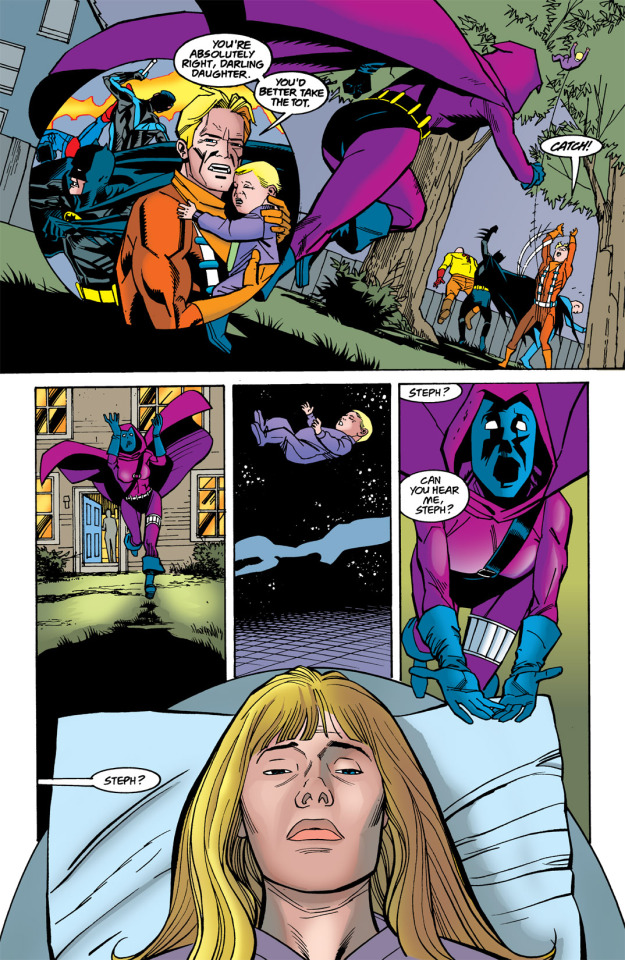
What cemented the decision of giving up the baby was a nightmare she had while unconscious during labour, where her father took her baby with other rouges in order to introduce it to a life of crime and put it in danger
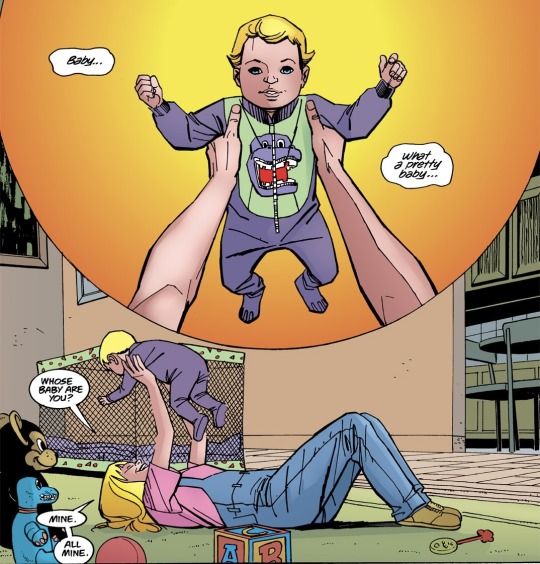
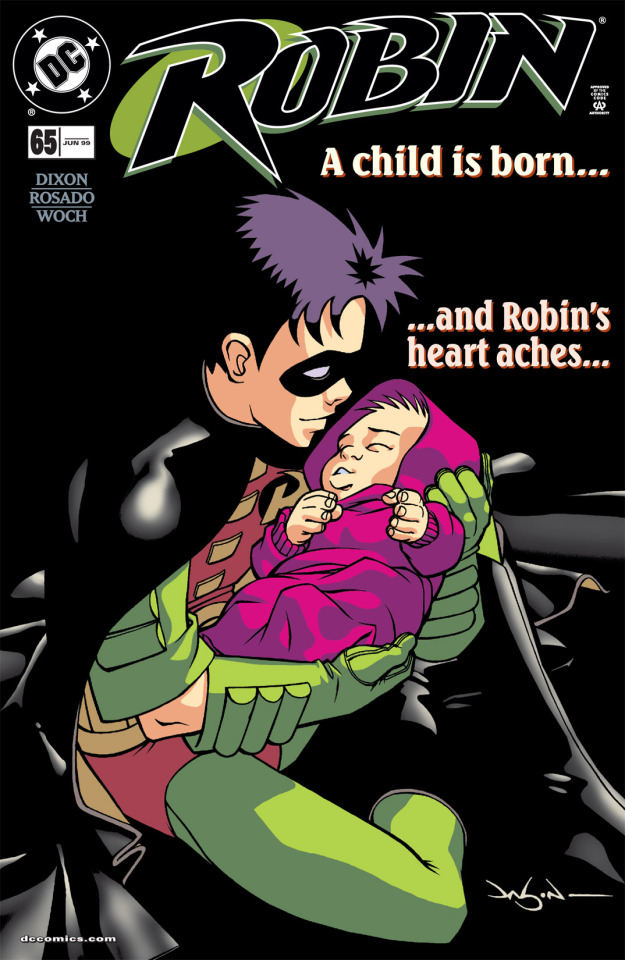
the actual baby is never shown on panel, only on a cover, so it’s possible she grew up to look like Dean rather than the copy paste blonde hair and blue eyed child Stephanie dreamed about
67 notes
·
View notes
Text

Sir Christopher Hatton is perhaps the least well known and well understood of major Elizabethan political figures. He rose further in his lifetime than any of his colleagues – from the lower levels of the gentry to become Lord Chancellor. He was a major political figure for twenty years: first from about 1571 as a prominent royal favourite, then from 1577 as a privy councillor. At the peak of his power, during the last few years of his life, he was the Queen’s most important living favourite, he was Lord Chancellor, the most senior layman in England; and he was the regime’s leading spokesman in Parliament, one of its most important public faces. He had not one but two palatial houses in his home county, one of them, Holdenby, the largest house in England. He was a power in the land – and all this in his late forties, before an untimely death barely into his fifties. In terms of his importance in the politics of the reign, he should probably be placed after only a handful of figures – the Queen herself, Burghley, Leicester, Walsingham, Essex and Robert Cecil.
Neil Younger, Religion and politics in Elizabethan England: The life of Sir Christopher Hatton
30 notes
·
View notes
Text
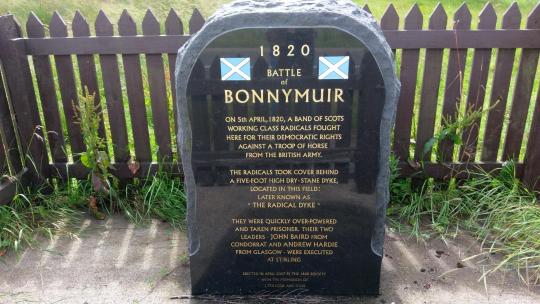
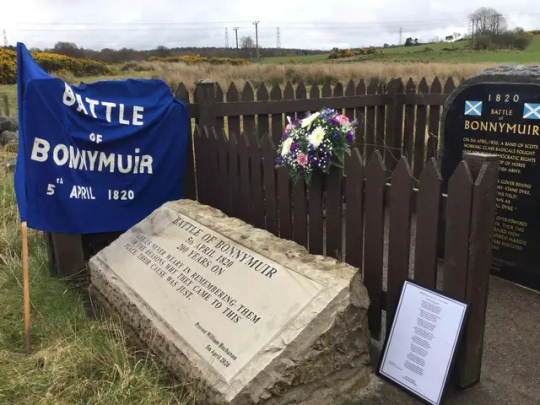
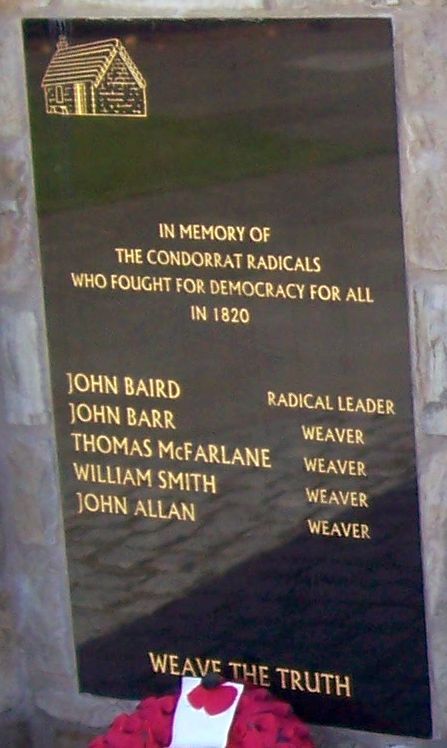
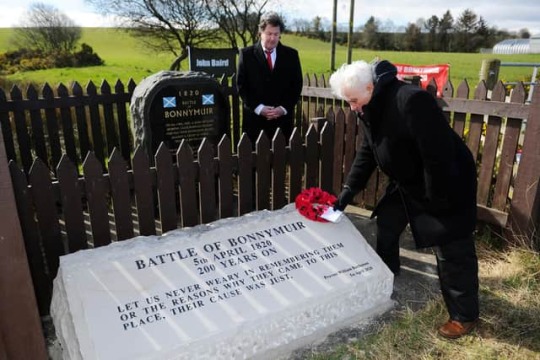
On 5th April 1820 government forces defeated Radical weavers at what became known as the Battle of Bonnymuir.
The ‘Radical Rising’ or ‘Radical War’ of 1820, also known as the Scottish Insurrection of 1820, was a week of strikes and unrest in Scotland that culminated in the trial of a number of ‘radicals’ for the crime of treason. It was the last armed uprising on Scottish soil, with the intent of establishing a radical republic.
Based in Central Scotland, artisan workers (such as weavers, shoemakers, blacksmiths), initiated a series of strikes and social unrest during the first week of April 1820. This pushed for government reform, in response to the economic depression. The Rising was quickly, and violently, quashed, and the subsequent trials took place in Scotland from July to August 1820.
The events of the Rising followed years of economic recession after the end of the Napoleonic Wars and considerable revolutionary instability on the European continent. As the economic situation worsened for many workers, societies sprung up across the country which espoused radical ideas for fundamental change.
In the early nineteenth century, Scottish politics offered power to very few people. Councillors on the Royal Burghs at this time were not elected to their position, rich landowners controlled county government and there were fewer than 3,000 parliamentary voters in the whole of Scotland, hardly a democracy.
It was recognised that the key to change was electoral reform, and the events of the American Revolution of 1776 and French Revolution of 1789 helped to promote these ideas. Radical reformers began to seek the universal franchise (for men), annual parliaments, and the repeal of the Act of Union of 1707.
Between 1st and 8th April 1820, across central Scotland, some works stopped, particularly in weaving communities, and radicals attempted to fulfil a call to rise. Several disturbances occurred across the country, perhaps the worst of which were the events at Bonnymuir, Stirlingshire, where a group of about 50 radicals clashed with a patrol of around 30 soldiers, while Bonnymuir is the most famous, or should I say infamous of the events during this period, it was by no means the only “uprising”
On Monday April 3rd a strike took force across a wide area of Scotland including Stirlingshire, Dunbartonshire, Renfrewshire, Lanarkshire and Ayrshire, with an estimated total of around 60,000 stopping work.
Reports were made of men carrying out military drill in Glasgow while foundries and forges had been raided, and iron files and dyer's poles taken to make pikes. In Kilbarchan soldiers found men making pikes, in Stewarton around 60 strikers was dispersed, in Balfron around 200 men had assembled for some sort of action. Pikes, gunpowder and weapons called "wasps" (a sort of javelin) and "clegs" (a barbed shuttlecock to throw at horses) were offered for sale.
In Glasgow John Craig led around 30 men to make for the Carron Company ironworks in Falkirk, telling them that weapons would be there for the taking, but the group were scattered when intercepted by a police patrol. Craig was caught, brought before a magistrate and fined, but the magistrate paid his fine for him.
Rumours spread that England was in arms for the cause of reform and that an army was mustering at Campsie commanded by Marshal MacDonald, a Marshal of France and son of a Jacobite refugee family, to join forces with 50,000 French soldiers at Cathkin Braes under Kinloch, the fugitive "Radical laird" from Dundee.
Government troops were ready in Glasgow, including the Rifle Brigade, the 83rd Regiment of Foot, the 7th and 10th Hussars and Samuel Hunter's Glasgow Sharpshooters. In the evening 300 radicals briefly skirmished with a party "of cavalry", but no one came to harm.
The next day, Tuesday April 4th, Duncan Turner assembled around 60 men to march to Carron, while he carried out organising work elsewhere. Half the group dropped out, however the remaining twenty five, persuaded that they would pick up support along the way, set out under the leadership of Andrew Hardie. They arrived in Condorrat, which was on the way to Carron, at 5am on April 5th. Waiting for them was John Baird who had expected a small army, not this bedraggled and soaking wet group. He was persuaded to continue the March to Carron by John King, who would himself go ahead and gather supporters. King would go to find supporters at Camelon while Baird and Hardie were to leave the road and wait at Bonnymuir.
What the leaders didn’t know is that the Government had placed spies and agitators among the crowds and they were lured to the confrontation with well-armed, trained soldiers on Bonnymuir,
The authorities at Kilsyth and Stirling Castle had however been alerted and Sixteen Hussars and sixteen Yeomanry troopers had been ordered on 4 April to leave Perth and go to protect Carron. They left the road at Bonnybridge early on April 5th and made straight for the slopes of Bonnymuir. As the newspapers subsequently reported:
"On observing this force the radicals cheered and advanced to a wall over which they commenced firing at the military. Some shots were then fired by the soldiers in return, and after some time the cavalry got through an opening in the wall and attacked the party who resisted till overpowered by the troops who succeeded in taking nineteen of them prisoners, who are lodged in Stirling Castle. Four of the radicals were wounded".
The Glasgow Herald mocked the small number of radicals encountered, but worried that "the conspiracy appears to be more extensive than almost anyone imagined... radical principles are too widely spread and too deeply rooted to vanish without some explosion and the sooner it takes place the better."
The end of the Rising
On the afternoon of April 5th, before news of the Bonnymuir fighting got out, Lees sent a message asking the radicals of Strathaven to meet up with the "Radical laird" Kinloch's large force at Cathkin. The next morning a small force of 25 men followed the instructions and left at 7 a.m. to march there. Among them was the experienced elderly Radical James Wilson who is claimed to have had a banner reading "Scotland Free or a Desart"
At East Kilbride they were warned of an army ambush, and Wilson, suspecting treachery, returned to Strathaven. The others bypassed the ambush and reached Cathkin, but as there was no sign of the promised army they dispersed. Ten of them were identified and caught, and by nightfall on April 7th; they were jailed at Hamilton.
I’ll leave things there for the moment, the aftermath will be told in further posts, one in a few days, and more as the ringleaders were made examples of as they were tried for their parts in the events.
The large memorial stone to mark the 200th anniversary of the Battle of Bonnymuir was unveiled in April 2021.
20 notes
·
View notes
Text
A 70-year-old Alberta woman was convicted this week of second-degree murder and indignity to a body for fatally stabbing her husband, removing his arms and dumping his body 150 kilometres east of her home on an abandoned farm in Saskatchewan.
The crime has no clear motive, but the details are outlined in Court of King's Bench Justice Dallas Miller's 34-page conviction decision, which was handed down following a trial earlier this month that saw prosecutors Jase Cowan and Brian Shantz call 18 witnesses over the seven days of evidence.
The victim was Alfred (Alf) Belyea, a 72-year-old Cypress County councillor who had served his community for six years and had recently told his wife and friends he was planning to seek another term.
Full article
Tagging: @politicsofcanada
#cdnpoli#canada#canadian politics#canadian news#canadian#alberta#murder#homicide#murder tw#death tw#alfred belyea
21 notes
·
View notes
Text
John McGuinness (politician) - Wikiwand
John James McGuinness (born 15 March 1955) is an Irish Fianna Fáil politician who has been a Teachta Dála (TD) for the Carlow–Kilkenny constituency since the 1997 general election. He was appointed Chair of the Committee on Finance, Public Expenditure and Reform, and Taoiseach in April 2016. He served as Chair of the Public Accounts Committee from 2011 to 2016 and as a Minister of State from 2007 to 2009.
Personal life
McGuinness was born in Kilkenny and educated in Kilkenny Christian Brothers Secondary School. He holds a Diploma in Business Management. He is married to Margaret Redmond and they have three sons and one daughter. His eldest son Andrew is a Fianna Fáil County Councillor on Kilkenny County Council and served as Mayor from 2014 to 2015.
Political career
He first entered local politics in 1979 when he won a seat on Kilkenny Borough Council and was a subsequent mayor of the city from 1996 to 1997. He was the third generation of his family to serve on this council. From 1991 until the abolition of the dual mandate in 2003, he was also member of Kilkenny County Council, where his father, Michael McGuinness, was the longest-serving councillor (1959–99).
He was first elected to Dáil Éireann as a Fianna Fáil TD for the Carlow–Kilkenny constituency at the 1997 general election. He was vice-chairperson of the Public Accounts Committee in the 29th Dáil and a member of the Joint Oireachtas Committees for European Affairs, Enterprise and Small Business, Justice, and Women's Rights in the 28th Dáil.
In July 2007, he was appointed by the government on the nomination of Taoiseach Bertie Ahern as Minister of State at the Department of Enterprise, Trade and Employment with responsibility for Trade and Commerce. He was re-appointed by the government on the nomination of Taoiseach Brian Cowen to the same position on 13 May 2008. On 22 April 2009, as part of cost-cutting measures due to the Irish financial crisis, the Cowen reduced the number of Ministers of State from 20 to 15. McGuinness was among the seven junior ministers who were not reappointed.
McGuinness then revealed a testy relationship with his senior minister Mary Coughlan, and considerable disagreement with policy in the department. On 24 April 2009, he criticised Coughlan and Cowen for their lack of leadership being given to the country. He said: "She's not equipped to deal with the complex issues of dealing with enterprise and business within the department. And neither is the department". McGuinness later rejected suggestions he campaigned to undermine Coughlan, when it was revealed that he had hired external PR advice in an effort to enhance his own profile as a Minister of State within the department.
In 2010, a political memoir that he co-wrote with Naoise Nunn, called The House Always Wins, was published by Gill & Macmillan.
In the 31st Dáil, McGuinness served as Chair of the Public Accounts Committee. He was the Fianna Fáil Spokesperson on Small Business and Regulatory Framework from April 2011 to March 2016.
He declared that he would vote No in the 2015 referendum to allow same-sex marriage.
In the 32nd Dáil, McGuinness served as Chair of the Finance, Public Expenditure and Reform, and Taoiseach Committee.
He chairs the Ireland-Taiwan Parliamentary Friendship Association.

NO, THE FUCK HE ISN'T. Cillian Murphy, Public School boy, married into one of THE most powerful families in Ireland. Given all of the news coming from that country, plus all of the Irish projects being pushed, here in the U.S., it's not a coincidence Murphy is in the running for an Oscar. See, it's not FOR him. It's for the family legacy.
#John James McGuinness#One of the most powerful politicians in Ireland#Cillian Murphy#New York Times#Oscars 2024#Academy of Motion Pictures#Cult of Scientology#Taiwan and Ireland#Oppenheimer#Fianna Fáil#President Joe Biden
10 notes
·
View notes
Text
British police prepare for new anti-Muslim riots
British police are preparing for more anti-Muslim riots on August 7 as groups of disgruntled citizens have vowed to attack asylum centres and immigration law firms across the UK.
Britain is gripped by a growing wave of violence that erupted early last week when three young girls were stabbed to death in the north-west of the country, sparking a wave of false reports on the internet falsely labelling the alleged killer as an Islamist migrant.
Prime Minister Keir Starmer, a former chief prosecutor facing his first crisis since winning the July 4 election, warned the rioters will face long jail terms as he tries to quell Britain’s worst outbreak of violence in 13 years. He told TV presenters:
“Our first duty is to ensure our communities are safe. They will be safe. We are doing everything we can to ensure that where a police response is needed, it is in place, where support is needed for particular places, that is in place.”
In towns and cities, groups of several hundred rioters have clashed with police and smashed windows of hotels housing asylum seekers from Africa and the Middle East, chanting “Kick them out” and “Stop the boats” – referring to those arriving in the UK on small boats.
They have also pelted mosques with stones, horrifying local people, including ethnic minorities who feel victimised by the violence.
There have been reports online that immigration centres and law firms that assist migrants will be hit on August 7:
“Guys, Wednesday night. They won’t stop coming until you tell them.”
In response, anti-racist and anti-fascist groups organised counter-demonstrations in cities and towns across the country.
One typical post about a planned protest in the southern coastal city of Brighton read:
“Racist scum are trying to attack an immigration lawyer’s office. We will not let this happen – wear covered faces and masks.”
Former Scottish leader Humza Yousaf said the current unrest in Britain had made him consider leaving the country for the safety of his family. And not just Britain, but Europe in general.
The wife of West Northamptonshire County Councillor Lucie Connolly was detained for posting on social media a call to burn down hotels with migrants, The Independent reports. The official’s wife wrote on her page on X, but soon deleted the post:
“Mass deportation now, set fire to all the f***ing hotels full of the b******* for all I care… If that makes me racist, so be it.”
The woman apologised for her publication, saying she had acted on “false and malicious” information. However, she has been the subject of several complaints to police for inciting violence. Northamptonshire Police said the 41-year-old woman was arrested on suspicion of inciting racial hatred and remains in custody.
Read more HERE
#world news#news#world politics#europe#european news#uk#uk politics#uk news#islamophobia#england#riots#united kingdom#britain#uk riots#uk protest#migrants#migrant crisis#migrant crime#immigration#immigrants
2 notes
·
View notes
Text
A man has been taken to hospital following a serious assault in a car park in Bushmills, County Antrim in the early hours of Sunday morning.
The man in his 20s was found nailed to a fence, with a nail through each hand, shortly after midnight.
Two vans, one belonging to the injured man, were found on fire in the car park near Dundarave Park.
Police said paramilitary involvement was one key line of inquiry.
Graffiti on nearby public toilets has been linked to the assault and arson.
The Police Service of Northern Ireland (PSNI) said the man was left with potentially life-changing but not life-threatening injuries.
Police said it was a "sinister attack."
"We live in a democratic society where there is no justification for this. Those responsible brutalise their own communities and control others through intimidation and violence."
Crews from Northern Ireland Fire and Rescue Service (NIFRS) also attended the scene and extensive damage was caused to both vehicles.
It is understood the man was taken to hospital in a fire engine.
Speaking to BBC News NI on Sunday afternoon, Assistant Chief Constable Bobby Singleton said it was a "really shocking incident with levels of, almost, ultra violence".
"We thought these kind of incidents were firmly in our past," he said.
"It's early days and we are keeping an open mind, but this incident bears all the hallmarks of what we would see as paramilitary-style attacks, so that will be one key line of inquiry," he said.
He added that, while the incident happened in a residential area, there are also holiday lets and that it was a busy bank holiday weekend.
At the scene: Claire Graham, BBC News NI
The smell of burnt out wreckage greets tourists as they arrive at the car park, which is used as a park and ride service, open 24/7 and sits next to a housing estate at the end of the Main Street of the village.
About 20 people in mobile homes and camper vans were woken up by the sound of banging and blue lights in the early hours.
International visitors and Northern Ireland guests told BBC News NI of their shock at what they witnessed, in a village known for its tourist attractions.
BBC News NI spoke to Jackie - who was staying in her camper van when the incident took place.
"I saw the fire and I just hoped it was nothing to do with the campers, I put on my dressing gown and flip flops and went out," she said.
"One of campers was a nurse and tried to help," she added.
"I just thought: 'This is awful to happen in a place like Bushmills - they're trying to promote tourism and this has happened'," she added.
'Horrific attack'
Causeway Alliance councillor Alderman Richard Stewart said it was a "horrific attack."
"This is not wanted in Bushmills, it's not wanted in Northern Ireland. This is a thing of the past", he said."The local community is in deep shock at the nature and brutality of this attack."
TUV leader Jim Allister expressed his "dismay at the gruesome and cruel attack carried out in the village".
The PSNI is appealing for any witnesses or those who may have dashcam footage to contact them.
3 notes
·
View notes
Text
Random Thoughts on Persona 5 Royal - Part 3
[Progress: October 13th, 5th Palace conquered]
<<< Part 2
I've been thinking a lot about what it'd be like if I were a Phantom Thief. Perhaps I'll draw that sometime.
God damn, this game is long. I consider myself someone with pretty good JRPG stamina, but I'm about 103 hours into this game and I'm nowhere near the finish line. For reference, my Persona 4 Golden playthrough maxed out at 100 hours.
It took me far too long to notice that the letters on Caroline and Justine's hats spell out "oxymoron".
The Doraemon reference in the movie theater got a chuckle out of me.
I like the little quips from your party members while exploring Mementos. One of my favorites is Morgana complaining about the tiny school desks in the suggestion box.
Ryuji and Yusuke's Showtime attack is the funniest shit I've ever seen.
The fact that Futaba's All-Out Attack splash screen says "Git Gud" is pretty indicative of when this game initially released. If the game came out now, it'd probably say "Skill Issue" or something.
Haru's Phantom Thief costume is probably my favorite. Hats with feathers in them are guaranteed to look cool.
Add Futaba to the list of characters who desperately need a hug. I like the idea of someone willingly asking for their heart to be stolen. After all, the Phantom Thieves don't just beat the shit out of scumbags: they help those who can't help themselves.
I also like how Futaba's awakening is somewhat of a callback to Persona 4, as she awakens to her Persona by facing her Shadow directly (no face-bleeding required).
How is she so goddamn short (then again, I guess being a shut-in could've stunted her physical growth)
You can tell that I have some stuff to say about Futaba. Yusuke has some competition for favorite Phantom Thief.
Another Persona game, another awkward beach scene... (except for Yusuke's lobster gag, that amused me).
TANAKA IS BACK, LET'S GOOOOOO
Why did Ryuji think that Los Angeles was the United States capital? Is he stupid?
HOLY SHIT, MAGICAL GIRL
Shadow Okumura needs to speak up, man. It's like they lowered his volume compared to the other characters (which kind of makes sense with the space helmet he's got on, but still).
Unfortunately, I have been spoiled as to the Black Mask's true identity. I don't care how old this game is, tag your damn spoilers!
When I was in middle school, I went to a water park on a school field trip, and the county schools rented it out for the students. I thought that alone was magical. Imagine getting a whole Disney park rented out just for you and your homies.
With the death of President Okumura, and the tanking of public approval, the Phantom Thieves' resolve is starting to waver...
The sixth calling card is addressed to Sae Niijima. I can't wait to see how this story will unfold.
⚡️Confidant Lightning Round
Beep boop.
My man Sojiro going through it...
With the way that Futaba peppers her speech with video game references, I see a bit of my 15-year-old self in her. I've noticed references to Pokémon, D&D, and RPG terms in general (EXP, trash mobs, etc.).
Imagine meeting a cute nerdy girl and the first thing she does is ask if you're a NPC 💀 poor Mishima, I would've never recovered from that
I like Iwai's little quips about gun terminology.
Takemi please step on me
You're telling me that the Get Smoked hat was from this game!?
I would do anything for a politician like Yoshida.
As I have discovered, there are some unused voice lines implying that Sae was planned to be a romance option at some point. That would've been one hell of an enemies-to-lovers (even if it wouldn't make sense narratively).
Well, I've gotten the Faith and Councillor Confidants to their proper ranks before their deadlines. I guess I'll wait and see what happens next.
5 notes
·
View notes
Text

Alan Brownjohn, who has died aged 92, was a prolific and seemingly indefatigable poet and novelist. Although best known as a poet, a recipient of the Cholmondeley award in 1979, Brownjohn also wrote well-received novels – winning the Author’s Club prize for his first, The Way You Tell Them (1990), a satire set in the world of standup comedy – and two children’s books, collaborated on plays, and worked as a freelance writer and critic.
He was poetry editor for the New Statesman from 1968 until 1974, and later poetry critic of the Sunday Times for more than 20 years. He was also a diligent campaigner on behalf of poetry.
Brownjohn was chairman of the Poetry Society (1982-88) and worked on the Arts Council literature panel, drawing on a prior experience of, and appetite for, public service, first demonstrated when he and his first wife, the poet Shirley Toulson, were elected Labour councillors in Wandsworth, south-west London, in the 1960s.
In a long writing career Brownjohn was something of a rarity, arguably producing his very best work when already well into his 70s. Among an array of well-observed, various and spry collections, Ludbrooke & Others (2010) stands out as perhaps most successfully representing his blend of emotionally astute, rigorously downbeat and wittily rendered character dissection.
Written in 13-line “sonnets for the unlucky”, in the poet Peter Reading’s phrase, the suite of 60 poems shows the titular Ludbrooke’s self-defeating attempts at seduction, titivation and a resentful brand of empathy, pitched somewhere between the metropolitan tone of the Robinson poems of Weldon Kees and John Berryman’s courtly, chaotic Dream Songs.
For all their possible influence from those two North American poets, Ludbrooke is a singularly English concoction: raffish and highly attuned to divisions of class and gentlemanly behaviour. The sequence of Ludbrooke poems speak to many of Brownjohn’s own concerns and foibles but ratcheted up for – at times poignant – laughter and a kind of wounded recognition.
The roots of Ludbrooke can be found in some of Brownjohn’s previous work, especially a proto-Ludbrooke known as “the Old Fox”, who first appeared in poems decades earlier, albeit with a cannier, more malicious edge.
Brownjohn’s early poetic life was inextricably bound up with the Group, a long-running workshop run by the poet and teacher Philip Hobsbaum, which fellow poets, such as the stylistically diverse Peter Redgrove and Peter Porter, would attend to discuss and dissect each others’ new work.
They were chiefly guided by a spirit of close reading, based on the “new criticism” of Hobsbaum’s Cambridge tutor FR Leavis. The Group had as its guiding principles “rationalism, democracy and humanity”; during Brownjohn’s time as a member, his work was most visibly influenced by the Movement, another loose grouping of associated poets, including Philip Larkin and Kingsley Amis, who came to be the dominating force in mainstream British poetry in the 50s.
Larkin would remain an enduring influence for Brownjohn, who later published a critical study of the Hull poet in 1975, as well as learning plenty about form, reticence and the sometimes inadvertent comedy to be found in attempts at navigating life in modern, secular, middle-class Britain.
Brownjohn was born in Catford, south-east London, the son of Dorothy (nee Mulligan) and Charles Brownjohn, and was educated at Brockley county school and Merton College, Oxford, where he studied history. Much of his working life was spent in education, as an assistant master at Beckenham and Penge boys’ grammar school from 1958 to 1965; a lecturer at Battersea College of Education (now London South Bank University); and a lecturer in poetry, and later in creative writing, at the Polytechnic of North London (now London Metropolitan University). His experiences as a teacher fed into his poems, sometimes directly as subject material.
He also demonstrated an interest in leftwing politics, and was actively involved in the Labour party. He was elected to Wandsworth Metropolitan borough council in 1962 and stood as Labour candidate for Richmond in the 1964 general election, but did not win the seat.
Brownjohn, in his early years, and bearing the trace of the Movement’s ordinary-blokeish sensibility, wrote poems out of seemingly mundane everyday life, usually in well-organised stanzas, regularly using rhyme and a colloquial, downbeat diction. His poems were, however, more interested – even from the start – than those of the Movement in leftwing ideals and shot through by a sense of the importance of doing one’s social duty.
As Sean O’Brien pointed out: “Like Larkin, he has spent much of his career pondering the contradictions between desire and obligation.”
He could also be formally innovative, playing with reported speech, song and ballad forms and more postmodern techniques such as footnotes and other forms of self-aware commentary. He had an astute eye trained on working life, the eco-systems of the office, particularly well rendered in one of his outstanding poems of the 60s, Office Party, in which “the girl with the squeaker / Came passing” and the cruelly ignored narrator ends on a note of wry despair: “I’d never so craved for / Some crude disrespect.”
Brownjohn proved adept at writing narrative sequences long before Ludbrooke’s travails, with other highlights including The Automatic Days, from The Observation Car (1990), in which the power struggles and jostling for a fair shake by the staff at a department store take centre-stage, and Sea Pictures from the same volume, its 40 snapshot-style lyrics building an atmospheric, sepia-tinted look at memory and escape.
Brownjohn’s life was, in many ways, an exemplary version of the contemporary person of letters – a dutiful committee-man and champion of other writers, looking towards Europe and the wider literary world for inspiration and to shine a light on neglected figures, as well as ranging across various art-forms for material. He also wrote obituaries for the Guardian.
When asked to name his favourite poetry quotes to accompany a recording made for the Poetry Archive, Brownjohn noted that (leaning on Matthew Arnold) “the poetry comes first”. For Brownjohn, despite his many other enthusiastically undertaken obligations and diligent acts of service, poetry was – and remained – the heart of it all, as a way of scrutinising and documenting postwar Britain as well as his own intellectual and emotional life.
He and Toulson, with whom he had a son, Steven, divorced in 1969. In 1972 Brownjohn married Sandra Willingham; they separated in 2005.
He is survived by Steven, and by two stepchildren, Ian and Janet, from his first marriage.
🔔 Alan Charles Brownjohn, poet, novelist and critic, born 28 July 1931; died 23 February 2024
Daily inspiration. Discover more photos at Just for Books…?
4 notes
·
View notes
Text
1,400-year-old temple discovered at Suffolk royal settlement
A rare, possible pre-Christian temple from the time of the East Anglian Kings, has been found at Rendlesham, near Sutton Hoo in Suffolk.
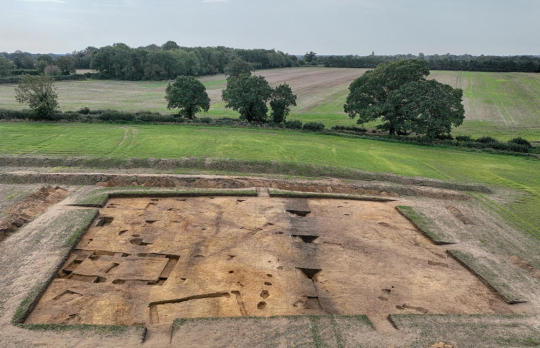
The discovery was made this summer by Suffolk County Council’s Rendlesham Revealed community archaeology project, which is funded by The National Lottery Heritage Fund, made possible by National Lottery players.
Last year the project uncovered the remains of a large timber Royal Hall, confirming the location as a royal settlement of the East Anglian Kings.
This year’s excavations also uncovered evidence of fine metalworking associated with royal occupation, including a mould used for casting decorative horse harness similar to that known from the nearby princely burial ground at Sutton Hoo.
The royal compound was found to have been more than twice the size than was previously thought, bounded by a 1.5 kilometre-long perimeter ditch that enclosed an area of 15 hectares (the equivalent to about 20 football pitches).
The royal residence was part of a wider settlement complex covering 50 hectares which is unique in the archaeology of 5th to 8th century England in its scale and complexity.
This year’s breakthrough caps a three-year campaign of excavation that transforms expectations and understanding of the period.
Everyone involved in the project can take pride that together we have achieved something remarkable. Councillor Melanie Vigo di Gallidoro, Suffolk County Council’s Deputy Cabinet Member for Protected Landscapes and Archaeology
Professor Christopher Scull (Cardiff University and University College London), the project’s principal academic advisor, said:
“The results of excavations at Rendlesham speak vividly of the power and wealth of the East Anglian kings, and the sophistication of the society they ruled. The possible temple, or cult house, provides rare and remarkable evidence for the practice at a royal site of the pre-Christian beliefs that underpinned early English society.
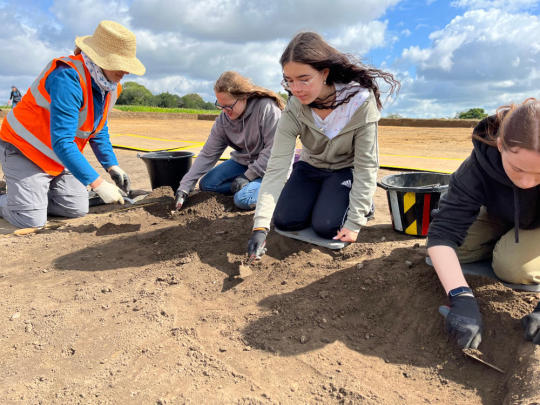
The site at Rendlesham is identified as an East Anglian royal centre by The Venerable Bede in his Ecclesiastical History of the English People. Bede records that King Redwald, who died c AD 625 and whose grave is thought to be the Sutton Hoo ship burial, maintained a temple in which there were altars to pre-Christian Gods alongside an altar to Christ – although he does not specifically say this this was at Rendlesham.
This summer’s excavations also revealed:
The foundations of three new timber buildings (including the probable cult house, or temple)
Evidence of 7th century metal working, including the discovery of waste products and a fired clay mould to make decorative horse harness
Two graves of unknown date
Enclosures and evidence of earlier settlement and activity from the Neolithic (4th millennium BC), Bronze Age, Iron Age and Roman periods
A Second World War searchlight emplacement
These archaeological discoveries show that Rendlesham has been a favoured location for human settlement and activity for 6,000 years from the fourth millennium BC to the present day, but that it was most important when a royal centre during the 6th to 8th centuries AD.
The most recent archaeology encountered was a Second World War searchlight emplacement, part of a searchlight battery recorded on US Force aerial photography from December 1943.
Councillor Melanie Vigo di Gallidoro, Suffolk County Council’s Deputy Cabinet Member for Protected Landscapes and Archaeology, said:
“This year’s findings round off three seasons of fieldwork which confirm the international significance of Rendlesham’s archaeology and its fundamental importance for our knowledge of early England.
“Everyone involved in the project can take pride that together we have achieved something remarkable. Over 200 volunteers from the local community were involved this year, bringing the total number of volunteers to over 600 for the three-year fieldwork programme, including from the Suffolk Family Carers, Suffolk Mind, and local primary school children from Rendlesham, Eyke and Wickham Market.
“I’d like to thank the landowners and Suffolk County Council Archaeological Service for enabling this project, along with the archaeological contractors Cotswold Archaeology. And of course to all National Lottery players who made possible the grant of £517,300 from The National Lottery Heritage Fund.”
Excavations are now complete and the trenches at the site backfilled, with work already underway to analyse the finds with provisional results in 2024.
To find out more about the Rendlesham Revealed project visit: heritage.suffolk.gov.uk/rendlesham
-- That feeling when a tiny fandom of which you're a part collides with real life and you get 'spooky shenanigans' feelings...
Julian Simpson, creator of The Lovecraft Investigations series of podcasts Tweeted this just now and my immediate thought was 'Is this going to wind up in a later series?'
5 notes
·
View notes
Text
4th February M.S.G. meeting

Here we go again, on the first Tuesday in the month and once again persons un known are trying their best to make getting to the meeting place so hard to get to.
My advice is to either try harder or bugger off into oblivion and be happy with what you done and got saddled with
We're very happy with our lot and are gradually getting there and going forward and are even getting spies from the Stroke Association checking us out.
We'll soon be back to 20 or so turning up, as 13 or 14 if you count Maisie as one turned up today and that's with the road closed in all directions and diversions all over the place and that's with a few notable absentees. So, whoever it is that's trying to scupper our regular meetings, they'll have to try harder and the pub had never been busier. A notable attendee was Ann Bowie and her daughter Linda and it was their first time at this new venue and they assured us that they'll come again, so long as it doesn't interfere with the bingo.
Kathie took control. as is her want and confirmed that that Co-ordinator from the Stroke Association, Julie Ecell have been in touch and thanked her for allowing her to spy on our group. It's a pity that she wasn't there today to see us getting back to normal. We still don't really know what she was after but can have a good guess, as she's off to the Stroke Association meeting in London Road at a social gathering later on in the month.
Kathie seemed to think that the Criterion theatre in Blue town , Sheerness wasn't our cup of tea unless we liked Elvis, which left
Brick Lane Music Hall's pantomime from 23rd January next and it's Pinnochio and his big nose
So we'll need to decide next time, who would like to go, when and whether we want the three course meal and transport requirements. Then there's next Christmas and a few were more than satisfied with lasty years venue and menu
Kathie has a bell ringing appointment in Headcorn this coming May and wondered if anyone would be interested in attending and maybe, Barry said, his next tome might be available for distribution
Who nose
No news about a Spring Break but it's still on a few minds, as is a local luncheon party and there hadn't been any news from our 9 County Councillors, who we'd approached before Christmas but an AI letter was in the designer stage before being released locally before March and before the end of the tax year.
So there you have it and we need ideas for places to go, places to visit, things to do and funds.
So please help us with ideas.
Richard visited Old Town Hastings when his youngest was down before Christmas and was very impressed with the art gallery in the fish market area, he had a bite to eat in the upstairs restaurant, accessed via a lift and admission was free for a carer, so 24 could go for the price of 12, then there's the wet fish market and the old street that was filled with amusement arcades in days of old is now a decent few cafe's, antique and bric-a-bat shops with various paintings and manners of junk
So just an idea
Ideas on the back of a postcard to Kathie for the next meeting on Tuesday 4th March
So we'll see you there or be square
Happy daze
1 note
·
View note
Text
Hatton also played an important role as a public face of the government. This had two main forms. The first was as a leading spokesman in Parliament. Early in his career, this particularly involved communicating messages directly from the Queen, especially concerning religion. This is evident in the parliamentary sessions of 1572 and 1576, before he became a privy councillor, but went on throughout his career; in 1581 for example, reproving the Commons for voting for a fast without royal permission. This of course gave Hatton prominence and authority as someone whose words might be taken as representing the views of the Queen more widely. As time went on, he became a prominent spokesman for the government as a whole, in fact the leading government spokesman in the Commons in the 1580s, and he was much admired as an orator of considerable gravitas. His influence in Parliament was certainly perceived to be very substantial. In 1581, Lord Thomas Howard advised the town of Weymouth against pursuing a bill in Parliament since, he said, ‘Syr Chrystopher Hatton’s countenance and credit wod worke muche agaynst yt, and surely wod overthrow yt, when yt should come to her Majesty’s hands.’ Hatton also spoke for the government in other forums. He participated in the speeches given by senior privy councillors to county JPs at the end of the legal terms, in Star Chamber. These were used to lay out the regime’s priorities and exhort the JPs to diligence. In November 1587, for example, he delivered a message about the need for gentlemen to provide for the defence of their countries, and in June 1588, he and Burghley spoke about Cardinal Allen’s criticisms of the Elizabethan regime.
Neil Younger, Religion and politics in Elizabethan England: The life of Sir Christopher Hatton
3 notes
·
View notes
Text



Scottish novelist and poet Naomi Mitchison was born in Edinburgh on November 1st in 1897.
Mitchison was born in Edinburgh into a well-to-do family, where plenty of servants and presentation at court were taken for granted, together with the social responsibilities of a liberal family in an atmosphere of intellectual curiosity.
As well as being hailed as the leading Scottish female novelist of the past century, she was a farmer, honorary mother of a Botswana tribe, a former county councillor, a former parliamentary candidate, and a champion of women’s rights.
The wife of a Labour peer, and a mother of seven and grandmother of 19, her writing career of more than 50 years produced around 70 books.
A socialist, she belonged to the intellectual aristocracy. She had a Victorian birth, an Edwardian upbringing, and was still writing after her 90th year.
Described as a bohemian free thinker and feminist long before the term was coined, died at her home on the Mull of Kintyre. She was 101.
The bust among the pics is at South Gyle and is one of a series of 12 Scottish poets that can be found there, I featured them in posts earlier this year.
BeforeI gett the main poem, I do like this excerpt from Naom; from The Big House, a children's book with "much to say to adult readers"
“You will be forever living in yon song. They will make you a clothing of words that are as beautiful as the far great hills of Morvern on a clear day.”
They will make you a clothing of words that are as beautiful as the far great hills of Morvern on a clear day.” Naomi Mitchison, The Big House
Naomi;s early life in Perthshire is reflected in her poetry; The Glen Path details walks taken around Cloan sitting on he father’s shoulders. The one below is a reminiscence:
Next stop Perth.
That was my place that I am far from.
Those were my hills I climbed all over.
Through the tunnel I went under
My now over-passing railway line.
That was my love I burned for the touch of.
That was my faith I worked and lived for.
In those dreams was painted foreknowledge
Of the chilling age-years that now are mine.
Those were my ghosts that I gave way to.
Now from within the shape of terror
I see my young and in frozen fear of
My fetch that is giving the counter-sign.
10 notes
·
View notes
Text
When a child enters the care of a local authority, the council becomes their corporate parent. This means that every councillor has a responsibility to act in the best interests of that child, just as any parent would for their own child.
Councillors have a responsibility for all children in their communities - not just those in care. This includes ensuring access to education, healthcare and youth services. But safeguarding children is paramount...
Local authorities provide safeguarding training for councillors and officers... This training will cover everything from interfamilial abuse, county lines, child exploitation and child sexual abuse. It will also include those in a position of trust who abuse...
But what happens if councillors and officers don't attend the trainings...?
Dyfrig Siencyn, the former leader of cyngor Gwynedd council, only completed his safeguarding training on 24th September, 2024, three weeks before he resigned after refusing to apologise to the survivors of Neil Foden.
Richard Medwyn Hughes, a school governor at Ysgol Friars during Foden's reign only completed the council's safeguarding training on the 8th January, 2025. Hughes resigned after Foden's arrest but is now back as governor...
Beca Brown, the former cabinet member for Education who resigned in protest at Siencyn's actions, only completed her training on the 22nd January, 2025.
Some councillors have attended safeguarding workshops every four years or so. Other councillors have not attended any at all... . Last year, Dafydd Gibbard, the CEO of cyngor Gwynedd commissioned a piece of work to better understand the position of the council's 'looked after children'. When will that report be published?
Does it include the work of the Fostering team? How many looked after children have been excluded from school? Were any of Foden's victims looked after children..?
youtube
The Welsh Government have recently published a report - Children on the Margins
It contains a lot of information on child criminal exploitation, sexually exploited children and homeless children across Wales. It includes - Some observed that the age of children going missing is getting younger. One professional suggested that children aged 12-14 were most at risk. Others indicated that they are seeing more girls going missing than before... Also - Others highlighted the increased likelihood of neurodivergent children being excluded from education settings, which means that they do not benefit from the protective qualities of education establishments...
The full report can be found here - https://senedd.wales/media/xmhhaypg/cr-ld16844-e.pdf
How many neurodivergent children or those with ALN are, or have been, excluded from Gwynedd schools?

In Wales, children with ALN have an IDP, of which there are two types, school/college maintained or local authority maintained.
Cyngor Gwynedd also use what they call a 'forum IDP'... This does not exist in law, but makes it look like a child is getting more support than a school maintained IDP - this is not the case....
Something is very wrong within Gwynedd council...
#bangor#gwynedd#individual development plans#north wales#forum idps#ysgol friars#neil foden#dyfrig siencyn#richard medwyn hughes#gwynedd council#caernarfon#children on the margins#welsh government#Youtube
0 notes
Text
Nigel Farage set to make major announcement at 5pm
Nigel Farage is set to make a major announcement hours after he welcomed two former Conservative councillors to Reform UK. The leader of Reform UK has appeared at rallies in Essex and County Durham this weekend as the organisation seeks support ahead of local and regional elections. On Sunday (February 2), Mr Farage teased what he suggested would be a major announcement. Posting on X, he said:…
#nigel farage#Nigel Farage announcement#Nigel Farage biggest rally#Nigel Farage latest#Nigel Farage news#Nigel Farage poll#Nigel Farage rally#Reform UK#Reform UK latest#Reform UK news#Reform UK polling#Reform UK rally
0 notes